Choosing the Right Stand Up Paddle Board for Your Needs
Choosing which paddle board to buy can be overwhelming. There are so many different options and brands out there, it’s enough to make anyone want to give up! What if I told you that there are some surprising tips for how to choose a paddle board? This blog post will tell you all about how to find the best paddle boards based on your experience, type of activity, weight, and what kind of water conditions you’ll be in! Follow these steps and before long, you’ll have bought yourself a new SUP!
What Should I look For When Buying a Paddle Board?
The activity you wish to get into with your sup is an important factor, there are so many benefits to paddle boarding that you’ll get a lot out of any one of them. When you’re looking to buy a paddle board to get started though, there are a number of things that you need to consider.
- Type of paddle boarding you’ll be doing
- Your weight
- Your experience level
- Your budget
The type of paddle boarding you’ll be doing is important as it will determine the best board for your needs. For example, if you’re looking to do yoga on a paddle board then a narrow longboard would not suit for that particular type of activity as you need a good amount of surface area. On the other hand, if you are going to use it to go surfing then you’ll need a shorter board preferably with a planing hull.
Your weight is important to consider because it will help determine the right amount of buoyancy that your board needs in order for you to paddle without feeling too low or uncomfortably high in the water.
Your experience and ability level will also be a factor to determine which type of board will work best for you. If you’re just starting out and want to learn how to paddle board, then a wider board would be the better option because they are more stable than narrower boards which is helpful if your balance isn’t perfect yet.
Your budget is an important consideration as well since prices can vary wildly with different SUP brands and models. There is no shortage of inexpensive paddle boards, but you will have to bear in mind that prices usually vary for a reason.
Types of Paddle Boards
There are a number of paddle board types as well as a variety of sup paddles, but people usually confuse the type of board with the activity that it’s used for. The general shape can be simplified into two main categories; those with a planing hull and those with a displacement hull.
The type of hull (bottom of the board), either displacement or planing, largely impacts how the board performs in water. Beginners can use either but should base their selection on how they want to use their SUP in future when they’re more experienced, as some are better at certain activities than others. If you want the best of both worlds you can actually buy hybrids now too.
Let’s look at sup hull types first.
Paddle Boards with a Planing Hull
This design is generally wider and has a more rounded nose, it’s more maneuverable as it sits higher in the water.
- The planing hulled type of paddle board is typically used for surfing, yoga and leisurely paddling.
Paddle Boards with a Displacement Hull
You can tell just by looking at the shape of the typical displacement hull paddleboard, that it’s built for speed.
- This type of stand-up paddle board with its pointed nose and streamlined shape is typically used for racing, touring and fitness paddling.
The racing aspect is obvious, but perhaps not the touring. Well, these types of boards actually take less effort than their counterparts as their shape makes them easier to paddle. These boards are designed to ‘displace’ the water and enable you to push through it easier.
This makes them the perfect race board and ideal as touring boards for paddling long distances with less effort.
They are usually longer and narrower than the planing hull which makes them less maneuverable but faster in straight lines.
Planing or displacement hulls can be found on both inflatable and solid stand up paddle boards.
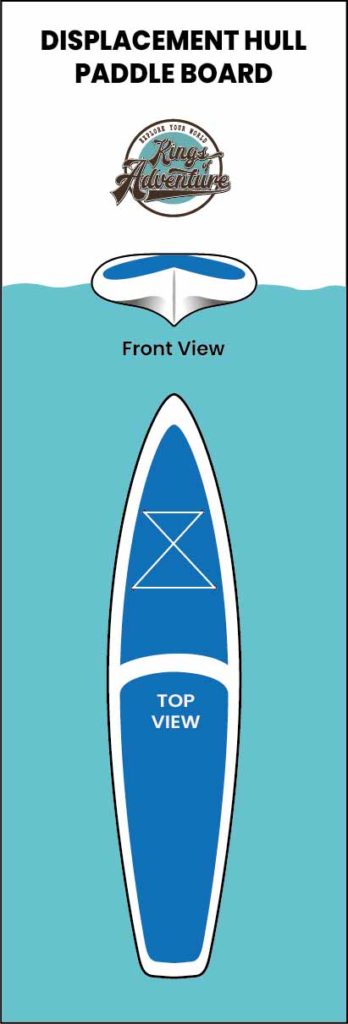
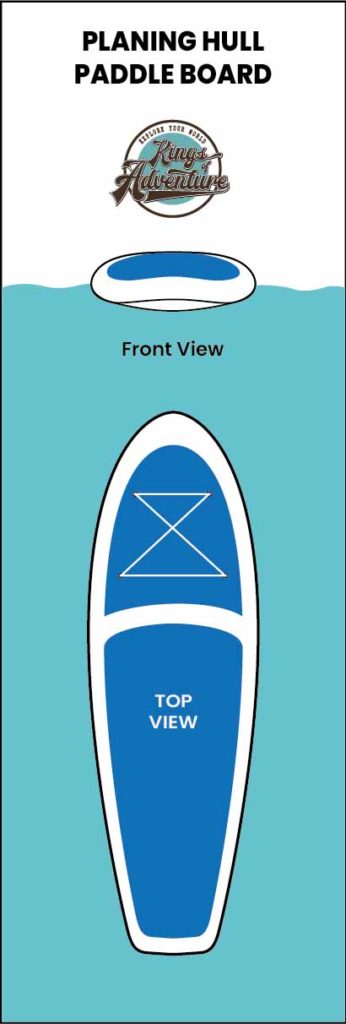
Inflatable or Solid Stand Up Paddle Board?
The answer to this question depends on your needs and preferences as a paddler. The obvious advantage of inflatable paddle boards is their ease of transportation. However, it has to be said that most paddlers who’ve owned inflatable paddle boards for a while tend to just leave them inflated because they can’t be bothered to inflate and deflate them constantly. The option to do so is always there though. Buy a solid board and you’ve no choice.
If you have ideas about using your sup to surf the waves, you can do so with an inflatable sup but it won’t have the performance of a solid board. A solid sup board has sharper rails (side edges) that cut into the waves better and so offer higher performance.
Benefits of a Solid SUP
- Better all round performance
- More choice
- Perfect for surfing
Benefits of an Inflatable SUP
- Portability
- Don’t damage as easy
- Better for yoga
Are Inflatable Paddle Boards Good for Beginners?
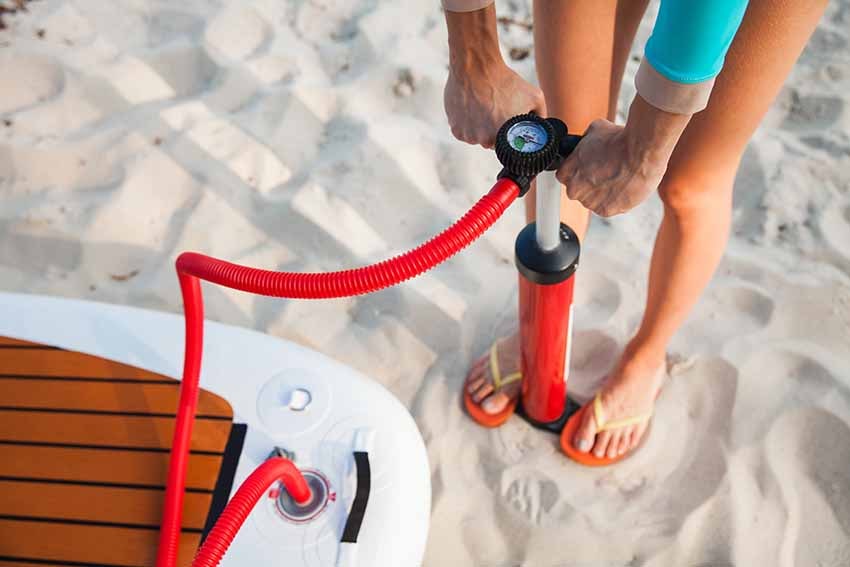
An inflatable sup is fine for someone who’s new to paddle boarding, they offer great stability and difficult to damage.
If you’re paddling near the shoreline or around rocky areas, an inflatable sup will be more forgiving and tend to bounce off rocks. Solid sup boards are more prone to damage in these circumstances. A beginner tends to have less control than an experienced paddler, bumps and scrapes are more commonplace.
If you like kneeling on your board for long periods or intend on using it for yoga, you will appreciate the softer surface of an inflatable board.
What Size Paddle Board do I Need for my Weight?
Instead of thinking board size, think board volume.
In order for your paddle board to perform well and to maximize stability, you must choose the correct volume of board to match your weight.
Each sup manufacturer provides volume and weight capacity specifications with their boards. The more volume the board has, the more weight it can carry. You should bear in mind any gear that you intend to regularly take on your board (yes that means your dog too) and factor this extra weight into your calculations.
If you choose a sup with insufficient weight capacity (volume too low for you and your cargo), the board will sit too low in the water, and performance will be poor. Stability and maneuverability will be compromised.
If you get the right board, paddling is far easier as your sup will lie in the correct position, displacing the correct amount of water.
What Length Paddle Board do I Need?
Some people believe that they need a longer board if they are taller, but this is incorrect.
As mentioned above, the most important factors are the board volume and the weight that it will be supporting. The length is important in this equation only as much as width and thickness, as combined they give us volume.
The thing you do need to know about board length is the impact it has on the board’s performance.
Short Boards
Boards under 10ft long are considered short boards.
If you see paddlers in the ocean enjoying the surf, it’ll usually be a shorter board and more than likely have a planing hull. These boards are easier to maneuver.
Ideal for: surfing | kids
Medium Sized Boards
Boards 10ft to 12ft are considered medium boards.
Again, the vast majority of boards in this size range are planing boards, with just a smattering of brands opting to put displacement hulls in this category.
This is considered the ‘all rounder’ size range as it is not specifically targeting ultra maneuverability or fast long distance paddling.
Ideal for: most paddling activities | yoga
Long Boards
Boards 12.5ft and above are considered long boards.
Most long board sups have displacement hulls and are built for speed and paddling longer distances.
Ideal for: racing | touring
SUP Width and Stability
You may have heard the phrase “width is king” when it comes to stand up paddle boards. This old saying holds true in this case because width has a major effect on how stable your board can be. A wider board will generally feel more stable than a narrower one.
A beginner will generally gravitate to a wider board as the feeling of greater stability will lead to greater confidence and surety.
There are usually compromises to be made though, as the wider the board, the slower it usually is and generally less maneuverable.
Also, if your board is too wide for your height, the efficiency and comfort of your paddling stroke will be compromised.
Width is your friend however if you are looking to use it for yoga practice. You’ll be grateful for that larger surface area when you’re trying to get into your yoga poses.
SUP Board Depth / Thickness
You should now be getting a picture of the criteria involved in determining which board is going to be right for you. The depth of the board (how thick it is) will have an obvious bearing on the boards’ volume.
Some paddlers who like to surf on their sup, prefer a thinner board as they feel that the sharper rails help to maneuver the board and cut into the wall of the wave.
Stand up paddle board thickness can be the variable that provides you with the optimum board in terms of volume and load capacity.
As an example, let us say that you wanted a fishing sup but the boards you wanted at your desired width were all the same length and didn’t provide your required carrying capacity for your weight! There may be options in the board range at a different depth that then met your required supporting volume.
What is the Best Fin Set Up for Paddle Boarding?
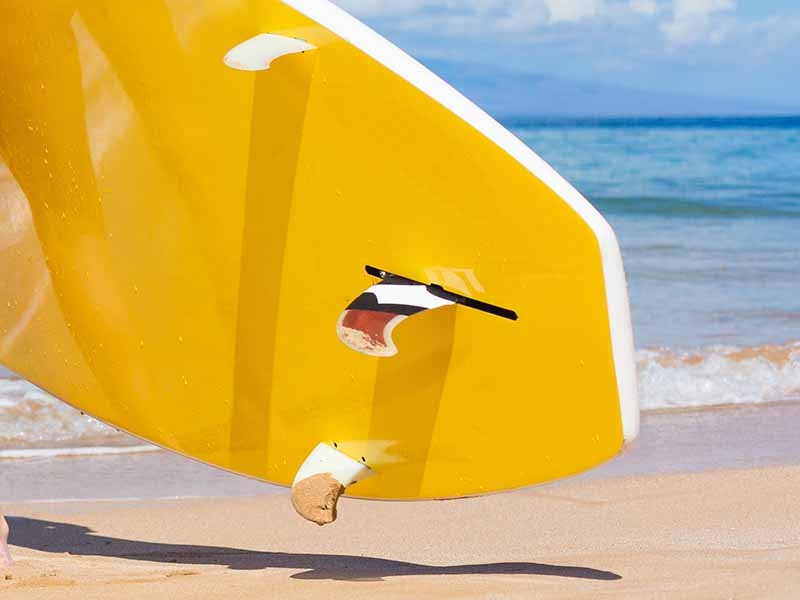
SUP fins provide an element of stability to your board, as well as control tracking.
Tracking is the ability to travel in a straight line on the water. If your sup had poor tracking you would have to switch sides after every stroke while paddling to maintain a consistent direction. Good tracking enables you to reduce the amount of switching and increase your paddling efficiency.
There are a number of fin arrangements and setups that facilitate certain aspects of performance when paddle boarding.
- 1 Fin, centered on the hull of your board at the rear, provides the least amount of drag and assists with tracking. Preferred by flat water paddlers (lakes)
- 3 x Same Size Fins provide excellent tracking
- 1 x Large Fin + 2 x Small Fins is the arrangement of choice for a lot of sup surfers.
How much should I spend on a paddle board?
Your budget is obviously a major factor in your purchasing decision, but it’s safe to say that you’re not short of options when it comes to price point.
Generally, as with anything, you tend to get what you pay for. There are so many new brands to choose from in the low-budget price bracket that it can be overwhelming to go through them all.
Prices range from $230 to $4000 plus! Brands that have been around for a while are usually a safe bet as you can dig into the review history and guage feedback from genuine buyers.
If you’re a beginner and not sure if you’re going to take to the sport, renting one for a day might be your first port of call. Just make sure you try and use the calculations in this article to get the right sup for renting too.
You don’t want to be put off the sport with a bad experience from a rented sup that wasn’t right for you.
If this is just a casual bit of fun and you don’t want to invest too strongly from the get go, you can pick up some decent inflatable sups for around the $300-$400 range.
If you’re looking for build quality and a reputable brand that specializes in sup development, $600- $1500 will get you a very good board that’s been researched and tested by professionals in the sport.
More specific sups such as specialized fishing boards etc can cost more.
Match Your Paddle Board to Your Activity
The following categories are guidelines and averages, there are of course boards that fall outside of these averages, but this gives you an overview of the general sup activity categories.
SUP Type: All Rounder
An all rounder sup is a board that will do a decent job for most paddling activities without excelling at any one thing, from flat water paddling to surfing. The board will have a medium thickness, and will enjoy a good amount of stability.
- Average sup length: 10′-11′
- Average width: 31″-35″
SUP Type: Surfing
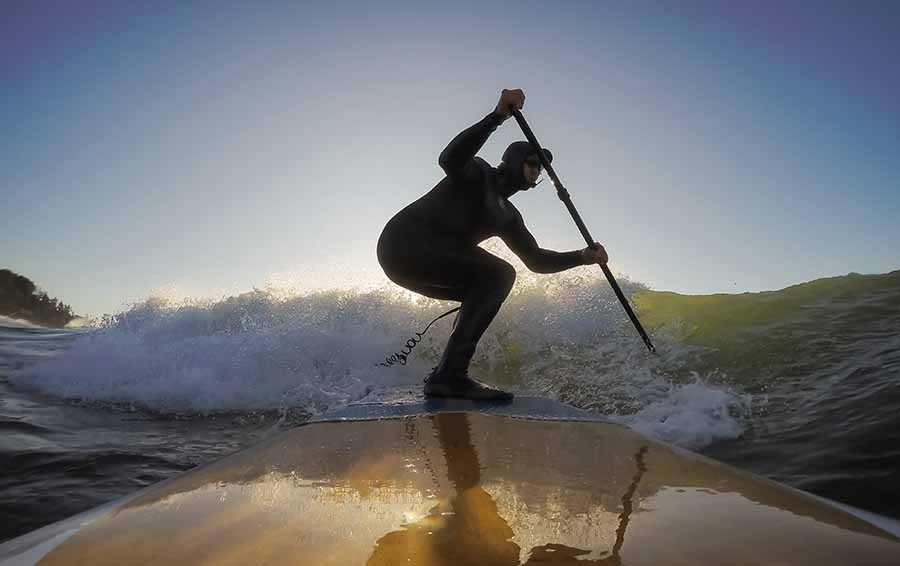
A surf sup board is often shorter in length than an all rounder sup. This means that it’s more manoeuvrable on waves but also a little less stable for flat water paddling etc. Surfing sups generally have a planing hull, rounded nose and narrow tail. The rounded nose allows for nose riding (standing at the front of the board while riding a wave), the majority will also have a kick pad at the rear that’s slightly raised, providing greater agility for turning.
- Average sup length: 8′-10′
- Average width: 28″-30″
SUP Type: Touring
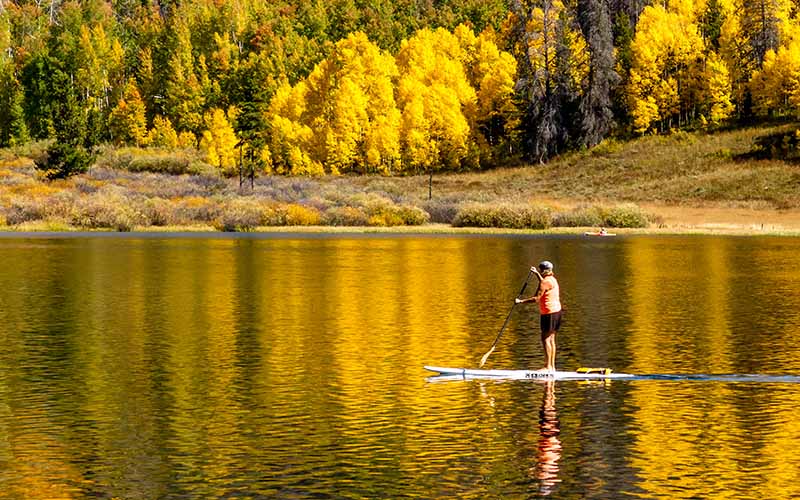
Touring boards are sups with displacement hulls, are long and narrow for cutting through flatwater with ease and at speed if desired. Touring boards are similar in design to racing boards but generally a bit wider and aimed at the long distance paddler
- Average sup size: 11′-12.5′
- Average width: 27″-30″
SUP Type: Racing
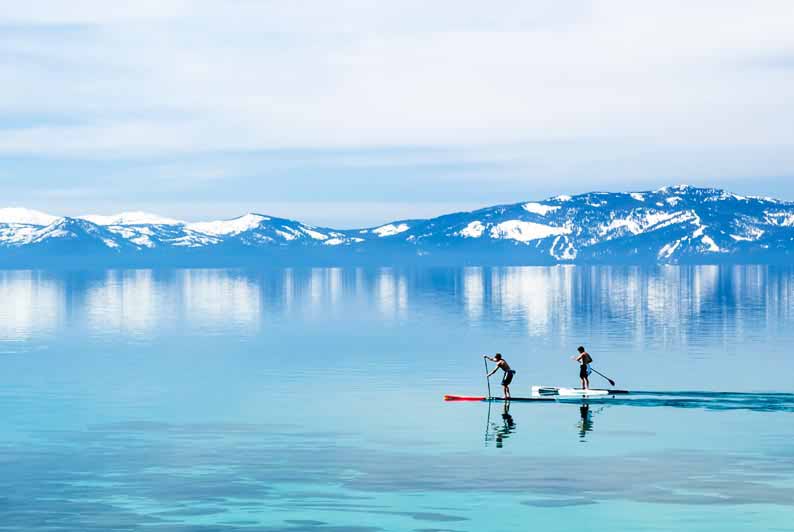
Racing sups have displacement hulls, are usually very long and very narrow with a pointed nose for ultimate speed. What these boards lack in width for stability they make up for in length. These sups are for experienced riders.
- Average sup size: 12′-14′
- Average width: 26″-28″
SUP Type: Fishing
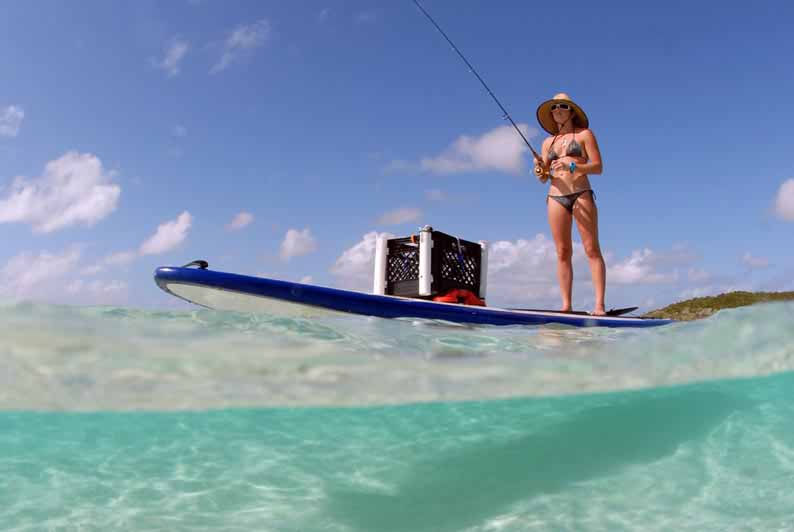
Fishing sups usually cost a little more than other types due to the accessories such as fishing racks, rod holders and the like. Sometimes these are purchased as addons.
- Average sup size: 10′-12′
- Average width: 32″-35″
SUP Type Yoga
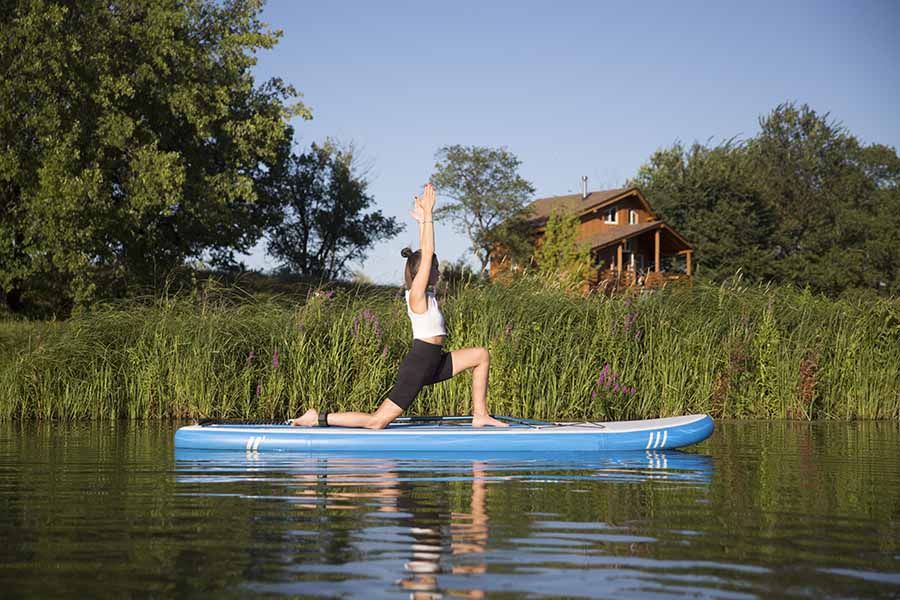
Paddle boards for yoga are mostly large inflatable sups with a planing hull. The greater width and soft surface means that you’ll be able to get into the majority of poses with comfort.
- Average sup size: 10′-12′
- Average width: 31″-35″
Conclusion: Finalizing your Decision
Because there are so many different types of sup boards to choose from, it can be hard to know what the best one is for your needs. We’ve done our research and picked out a few that we felt stood out in terms of quality, price point, features offered, and weight capacity. Our goal with this article was not only to educate you on all the options available but also help you narrow down your choices by providing specific information about each board type.
Hopefully, now that you have an idea of which type might work best for you based on your individual requirements (weight limit, water activity, experience etc.), it will make shopping around easier. We’ll see you on the water!

